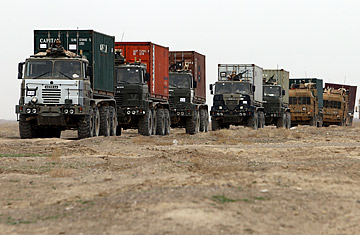
A convoy of military vehicles moves through southern Afghanistan's Helmand province, transporting heavy equipment for a base near Marjah
Measuring a quagmire is mostly guesswork. But a congressional report released last Monday, June 21, on the U.S.'s supply lines in Afghanistan comes close to putting at least one number on it: the $2.16 billion we pay a year to extortion rackets to protect U.S. truck convoys. What the problem comes down to is that in paying off Afghans to protect our supply lines, we have created a vast slush fund for bribery, extortion, heroin trafficking and murder. And it's all but certain that some of the money ends up in the pockets of the Taliban. In other words, we're paying for the bullets and bombs that kill our own soldiers.
The report, titled "Warlord, Inc.: Extortion and Corruption Across the U.S. Supply Chain in Afghanistan," is well worth reading in its entirety, if for no other reason than to get a glimpse of just how little ground we control in Afghanistan. For lack of troops and an absence of Afghan government authority, we've had no choice but to outsource security for 70% of our logistic lines to Afghans we know almost nothing about. For instance, the warlord in charge of security for supply convoys between Kabul and Kandahar apparently is known by only one name. He has connections to the Karzai family, but beyond that, he's a mystery. He's never been met by an American contracting officer, and his only meeting with any American officer was in a botched drug arrest. (He denies trafficking in narcotics.) Our ignorance about this man is all the more astonishing considering that the fate of any operation to retake Kandahar depends upon him. What if, in the middle of the battle, he joins the Taliban and cuts off supplies?
What's just as amazing is that the Administration understands the problem and has done nothing to correct it. In testimony before the Senate Foreign Relations Committee last December, Secretary of State Hillary Clinton bluntly put it this way: "One of the major sources of funding for the Taliban is the protection money."
The other U.S. supply route into Afghanistan — the independent states of ex-Soviet Central Asia — isn't much more dependable. Kyrgyzstan, which leases us the Manas base that serves as a resupply hub for the Bagram air base, is teetering on the abyss. Russian President Dmitri Medvedev said on Friday, June 25, that Kyrgyzstan is facing near certain disintegration. But that's not the end of it. The Kyrgyz subcontractors who supply fuel to Manas are caught up in bribery scandals, which very well could lead to our losing access to Manas when a new government rises to power and decides to seriously investigate them.
It is all the more ominous when this is put into historical context. The last general in landlocked Afghanistan to cede control of his logistics was William Elphinstone, who in January 1842 lost not only an army but also his life retreating across what should have been secure logistic lines. During the Soviet Union's 1979-89 invasion of Afghanistan, apparently absorbing Elphinstone's lesson, the Red Army made certain to provide its own troops to protect its supplies.
Another reason this congressional report is worth reading is that it gives us a glimmer of just how blind we are in Afghanistan. American military contracting officials haven't met the Afghan warlords protecting our convoys because they don't feel safe enough to get off base. Which leads to another question: If we know so little about the Afghans we outsource our supply lines to, supposedly our allies in the conflict, how much do we really know about the Taliban? When CIA Director Leon Panetta said on Sunday that a power-sharing arrangement with the Taliban is probably not going to work, he's no doubt right. But it's just good guesswork.
